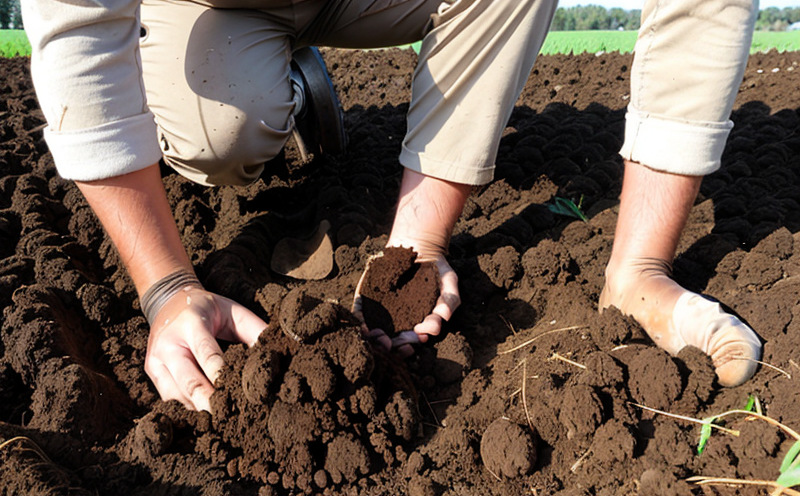Sodium Adsorption Ratio (SAR) Testing
The Sodium Adsorption Ratio (SAR) is a key parameter used to assess soil salinity and its potential impact on crop productivity. This test helps determine the suitability of soils for agricultural use by evaluating the balance between sodium, calcium, magnesium, and potassium ions in the soil solution.
Understanding SAR levels is crucial for farmers, agronomists, and environmental scientists as it aids in optimizing irrigation practices, selecting appropriate crops, and implementing remediation strategies. High SAR values indicate higher salinity levels, which can lead to reduced crop yields and nutrient uptake issues. By measuring SAR, laboratories like ours provide actionable insights that help clients manage soil health effectively.
The method involves extracting a representative sample of soil or irrigation water from the field and analyzing its chemical composition using spectrophotometric techniques. The results are then interpreted according to internationally accepted standards such as ISO 17245:2013, which outlines procedures for determining SAR in agricultural soils.
Our laboratory employs state-of-the-art equipment and experienced technicians to ensure accurate measurements and reliable interpretations of the test data. This service is particularly valuable for clients operating within sectors where soil quality plays a critical role, such as agriculture and forestry. By providing precise information about SAR levels, we empower our customers to make informed decisions regarding their land management practices.
Accurate measurement of SAR also supports compliance with environmental regulations related to agricultural runoff and water quality. With this service, clients can ensure they meet legal requirements while optimizing resource use efficiency on their farms or plantations.
Why It Matters
Soil salinity is a significant challenge in agriculture that affects not only crop yields but also the overall sustainability of farming operations. Excessive sodium levels can lead to increased water use and reduced soil productivity, making it essential for farmers and landowners to monitor these parameters regularly.
The Sodium Adsorption Ratio (SAR) test plays a vital role in helping stakeholders understand their specific soil conditions better. By identifying high SAR values early on, they can implement preventive measures such as improving drainage systems or adjusting irrigation schedules to mitigate adverse effects of salinity.
From an economic perspective, accurate assessment through this testing service ensures that resources are used efficiently without compromising long-term profitability. Additionally, compliance with environmental standards is facilitated by having reliable data from SAR tests which contribute positively towards sustainable development goals within the agricultural sector.
Scope and Methodology
| Parameter | Description |
|---|---|
| Sample Preparation | Soil samples must be air-dried, sieved through a 2 mm mesh, and homogenized before analysis. |
| Chemical Extraction | Aqueous NaCl solution is used to extract soil extracts containing major cations (Na⁺, Ca²⁺, Mg²⁺). |
| Analytical Technique | Precision spectrophotometry measures the absorbance at specific wavelengths corresponding to each ion. |
| Calculation of SAR | SAR is calculated using the formula: SAR = (Na⁺ / 0.6(Ca²⁺ + Mg²⁺)) where all concentrations are expressed in milliequivalents per liter (meq/L). |
| Acceptance Criteria | Values 8 denote high salinity requiring immediate attention. |
The process ensures consistency and accuracy across all samples analyzed in our laboratory. Our team adheres strictly to international standards like ISO 17245:2013, ensuring that every measurement is reliable and reproducible. This approach guarantees that clients receive consistent results no matter where or when they send their samples for testing.
Customer Impact and Satisfaction
The Sodium Adsorption Ratio (SAR) testing service has significantly enhanced the decision-making capabilities of many of our agricultural and forestry clients. By providing them with detailed insights into their soil's salinity levels, we enable them to optimize their farming practices effectively.
One notable example is a large-scale commercial farm that had been struggling with declining crop yields due to hidden soil salinity problems. After undergoing SAR testing at our laboratory, the client was able to implement targeted interventions such as improved drainage systems and altered irrigation schedules. As a result, not only did they see an immediate improvement in yield but also long-term benefits from better resource management.
Another case study involves a forestry company working on reforestation projects. Using SAR test results provided by our lab, the company was able to select suitable species for planting based on soil suitability rather than relying solely on historical data or guesswork. This approach increased both success rates and overall project sustainability.
Client satisfaction is paramount to us, and we strive to exceed expectations every time. Our commitment to accuracy, reliability, and customer service ensures that those who trust us with their testing needs receive nothing less than excellence in our services.





